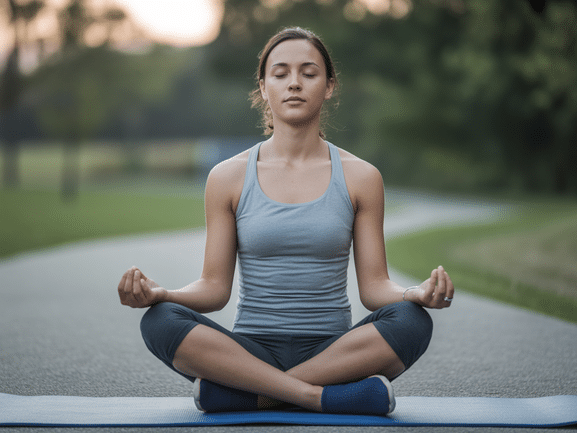5 Powerful Meditation Techniques to Overcome Insomnia Naturally
Do you find yourself staring at the ceiling at 2 AM, mind racing with thoughts while sleep feels impossibly distant? You’re not alone. Over 30% of adults worldwide struggle with insomnia, and many are seeking natural alternatives to sleeping pills.
The good news? Meditation for insomnia has been scientifically proven to improve sleep quality, reduce the time it takes to fall asleep, and help you stay asleep longer. Let’s explore five powerful techniques that can transform your nights from restless to restful.
“Meditation is not about stopping thoughts, but recognizing that we are more than our thoughts and our feelings.” – Arianna Huffington
Why Meditation Works for Insomnia
Before diving into techniques, it’s important to understand why mindfulness sleep techniques are so effective. When we meditate, our nervous system activates the parasympathetic response – often called the “rest and digest” mode. This natural shift:
- Reduces cortisol (stress hormone) levels
- Lowers heart rate and blood pressure
- Relaxes muscle tension
- Calms mental chatter
Research from Harvard Medical School shows that people who practice bedtime meditation fall asleep 50% faster than those who don’t. Additionally, the American Academy of Sleep Medicine recognizes meditation as an effective natural insomnia remedy.
1. Progressive Muscle Relaxation (PMR)
Progressive Muscle Relaxation is one of the most effective guided meditation sleep techniques for physical tension release. This method involves systematically tensing and then relaxing different muscle groups throughout your body.
How to Practice PMR:
- Lie down comfortably in your bed
- Start with your toes – tense them for 5 seconds, then release
- Move up to your calves, thighs, abdomen, arms, and face
- Notice the contrast between tension and relaxation
- End with three deep breaths
Best for: People who carry physical stress in their body or have trouble “switching off” from the day’s activities.
Many users of Vitalizen.app report that PMR helps them release the day’s tension within minutes, creating the perfect foundation for restful sleep.
2. The 4-7-8 Breathing Technique
Developed by Dr. Andrew Weil, this powerful breathing pattern acts as a natural sedative for the nervous system. The 4-7-8 technique is particularly effective for sleep anxiety relief.
Step-by-Step Guide:
- Exhale completely through your mouth
- Inhale through your nose for 4 counts
- Hold your breath for 7 counts
- Exhale through your mouth for 8 counts
- Repeat 3-4 cycles
Why it works: This breathing pattern increases oxygen in your bloodstream while activating your body’s relaxation response. Furthermore, the counting gives your mind something to focus on instead of worrying thoughts.
“The 4-7-8 breath is utterly simple, takes almost no time, requires no equipment and can be done anywhere.” – Dr. Andrew Weil
3. Body Scan Meditation
Body scan meditation is a cornerstone of mindfulness sleep techniques. This practice involves mentally “scanning” your body from head to toe, bringing awareness to each part without trying to change anything.
Practice Steps:
- Lie down and close your eyes
- Begin at the top of your head
- Slowly move attention down through each body part
- Notice sensations without judgment
- If your mind wanders, gently return to the scan
- End at your toes, then rest in whole-body awareness
Duration: 10-20 minutes is ideal, though even 5 minutes can be beneficial for beginners.
This technique is excellent for people whose insomnia stems from an overactive mind. By focusing on physical sensations, you redirect attention away from anxious thoughts. Learn more meditation techniques in our comprehensive blog.
4. Loving-Kindness Meditation for Sleep
While traditionally used for cultivating compassion, loving-kindness meditation is surprisingly effective for insomnia, especially when sleep troubles stem from stress, anger, or emotional turbulence.
How to Practice:
- Start by sending kind wishes to yourself: “May I be peaceful, may I be at ease”
- Extend these wishes to loved ones
- Include neutral people in your life
- Even include difficult people
- Finally, extend loving-kindness to all beings
Sleep benefits: This practice releases oxytocin (the “love hormone”) and reduces cortisol, creating ideal conditions for sleep. Moreover, it transforms negative emotions that might be keeping you awake.
Research from Stanford University shows that loving-kindness meditation significantly improves sleep quality in just seven weeks.
5. Mindful Visualization
Visualization meditation uses the power of imagination to create peaceful mental imagery. This technique is particularly effective as a natural insomnia remedy because it gives your busy mind something calming to focus on.
Popular Visualization Themes:
- Beach scene: Imagine waves gently lapping the shore
- Forest walk: Visualize a peaceful path through tall trees
- Mountain meadow: Picture yourself lying in soft grass under stars
- Floating cloud: Imagine resting on a soft, supportive cloud
Pro tip: Engage all your senses in the visualization


